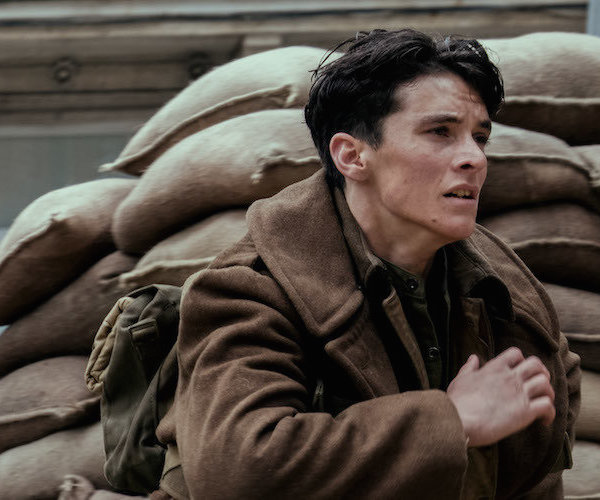Film Review: “Dunkirk” — An Epic Celebration of the Communal Spirit
Dunkirk is a rousing testament to how common people, when called, can unite against adversity.
Dunkirk, directed by Christopher Nolan. Now Playing Somerville Theatre, AMC Assembly Row in Somerville 12, Tremont Theatre, Boston, and other theaters throughout New England.

A scene from the epic war film “Dunkirk.”
By Tim Jackson
War movies are inevitably part of both the era they represent and the time in which they are created. Director Christopher Nolan’s latest film, Dunkirk, is an attempt to send a valuable message from one time to another. The World War II battle at the center of the narrative has come to signify a sense of hope through communal effort — and that is obviously n indictment of what is happening in the world today: too many governments seem to be morally corrupt, visionless, and indifferent to the struggles of the common man. What happened at Dunkirk was about perseverance, sacrifice, and a do-or-die commitment to the lives of members of a community. It was a major turning point in World War II — yet glory was an afterthought.
Dunkirk focuses on the embattled evacuation, by the Allies, of the beaches near a French city while it was under attack from enemy fire. On May 14 1940, a call went out on the BBC: “The Admiralty have made an order requesting all owners of self-propelled pleasure craft between 30ft and 100ft in length to send all particulars to the Admiralty within 14 days from today if they have not already been offered or requisitioned.” The rescue of the troops was achieved with the aid of small boats: private yachts, motor launches, lifeboats, steamers, and barges. Two hundred ships and boats were destroyed, including the destroyer Wakeful, which was torpedoed and sank in 15 seconds — 600 lives were lost. This was the largest evacuation in military history — over a period of 8 days 338,226 Allied soldiers were ferried across the English Channel, including 140,000 French, Polish, and Belgian troops.
Nolan’s Dunkirk follows the trials and tribulations of foot soldiers Gibson (Aneurin Barnard), Alex (Harry Styles), and Tommy (Fionn Whitehead), an RAF pilot (Tom Hardy), and a boatman (Mark Rylance) on his way to Dunkirk with his two sons. The latter rescue a shell-shocked soldier (Gillian Murphy). Naval Commander Bolton (Kenneth Branagh) and Army Col. Winnant (James D’Arcy) stand nobly on the pier, hoping for a naval rescue of hundreds of men who are the helpless targets of German aircraft. The sense of slaughter reflects Bob Dylan’s reference in his Nobel Prize speech to the World War I film All Quiet on the Western Front: “You’re stuck in a nightmare, sucked up into a mysterious whirlpool of death and pain. You’re defending yourself from elimination. You’re being wiped off the map.”
In order to evoke this sense of devastation, Nolan scrambles time sequences and jumps between extremes in terms of scale. Nolan cuts from epic battles on air, land, and sea to terrifying moments of individual struggle. Hans Zimmer’s pounding score underlines the contrast between panoramic scenes of combat and the terror of men trapped in confined spaces: tension is maintained without resorting to scenes of blood and gore. The enemy exists only as an anonymous and relentless force of death.
Nolan is a director who has deep enough pockets to shoot on 70mm film in authentic spaces with an enormous cast. The money was well spent — Dunkirk is an immersive and intense experience. The film’s nerve-rattling sound design ranges from Spitfire engines to bullets piecing metal. Refreshingly, the digital effects are minimal and the script’s dialogue is powerfully terse. One-on-one aerial dogfights jump from views of acrobatic confrontations in the sky to pilots’ eye views from cockpits. The horizon line tilts; clouds obscure the target. Enormous battleships are torpedoed and then slide into the sea — men leap into the water. While the timeline is ambiguous, the conflict’s human struggles are starkly portrayed: fear, paranoia, bravery, cowardice, shock, fate, life, death, salvation, and forgiveness.
The casting is an eclectic round-up. Harry Styles, from the boy band One Direction, is cast along with lots of lesser known actors. Of course, A-list British performers take on the iconic roles. Mark Rylance — all furrowed brow and rugged determination — stands for the resolute bravery of the civilian rescuers. Though we see his face for only a split second as he dons his pilot’s mask and goggles, Tom Hardy is convincing as the dogged Spitfire ace. Few actors can do more with less than Hardy (think of his Bane in Dark Knight and Mad Max). Branagh is given some fairly ridiculous lines to spout as he stands, undaunted and stiff-lipped, amidst the chaos around him. But this is a small flaw in what is an otherwise great film about “The Spirit of Dunkirk,” a rousing testament to how common people, when called, can unite against adversity.
Tim Jackson was an assistant professor of Digital Film and Video for 20 years. His music career in Boston began in the 1970s and includes some 20 groups, recordings, national and international tours, and contributions to film soundtracks. He studied theater and English as an undergraduate, and has also has worked helter skelter as an actor and member of SAG and AFTRA since the 1980s. He has directed three feature documentaries: Chaos and Order: Making American Theater about the American Repertory Theater; Radical Jesters, which profiles the practices of 11 interventionist artists and agit-prop performance groups; When Things Go Wrong: The Robin Lane Story, and the short film The American Gurner. He is a member of the Boston Society of Film Critics. You can read more of his work on his blog.
